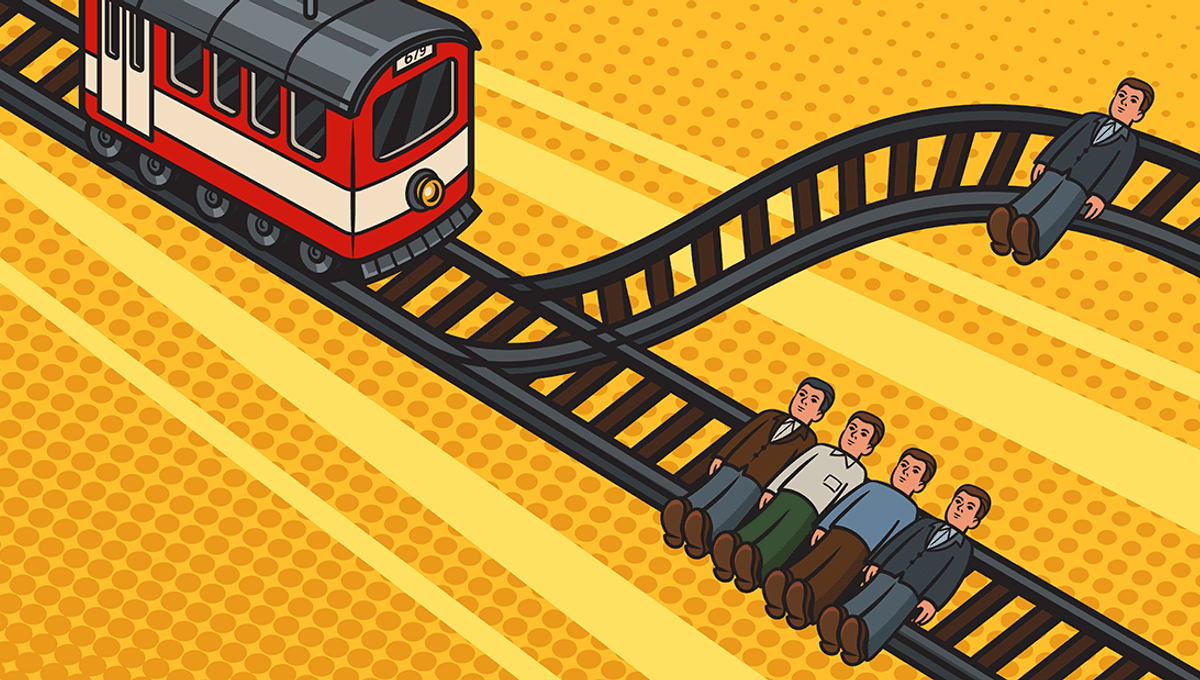
A YouTuber has recreated the trolley problem, the moral philosophy conundrum in which you are asked whether it is morally justifiable to kill one person in order to save five.
The original problem was posed by philosopher Philippa Foot, and later popularized in an article by philosopher Judith Jarvis Thomson.
“Suppose you are the driver of a trolley. The trolley rounds a bend, and there come into view ahead five track workmen, who have been repairing the track. The track goes through a bit of a valley at that point, and the sides are steep, so you must stop the trolley if you are to avoid running the five men down. You step on the brakes, but alas they don’t work. Now you suddenly see a spur of track leading off to the right,” Jarvis Thompson outlined in a paper.
“You can turn the trolley onto it, and thus save the five men on the straight track ahead. Unfortunately, Mrs. Foot has arranged that there is one track workman on that spur of track. He can no more get off the track in time than the five can, so you will kill him if you turn the trolley onto him. Is it morally permissible for you to turn the trolley? Everybody to whom I have put this hypothetical case says, Yes, it is.”
When asked in the abstract, the majority of people will say it is morally permissible to pull the lever, and kill one person to save five. Toddlers, meanwhile, will merely add the one person to the pile of five and let the train do its work.
But, let’s face it, the problem is pretty abstract. Make it less abstract, such as an update where you must push someone off a bridge to slow down the train before it hits five people, and fewer people believe it is the morally correct course of action.
So, what would people do in a real-life situation, or as close as we can approximate that without killing a lot of people on train tracks?
YouTube channel Vsauce tested this in a 2017 experiment, involving a number of deceptions to convince participants that they were really being presented with this choice.
Michael Stevens, who runs Vsauce, was aware that the experiment would convince participants that they had killed one or more people through action or inaction, should all go to plan. Attempting to minimize potential harm from conducting the experiment, his team told volunteers they were participating in a focus group, allowing them to screen out people with a history of mental illness or prior trauma from participating.
To conduct the experiment, Vsauce hired actors to portray workers standing on the tracks, and recording footage (spliced in later) of a train going down the tracks towards them. The seven participants, chosen by a clinical psychologist, were then told they were taking part in a focus test near an old train station.
While they were waiting for the “test” to begin, they were offered the chance to cool down in the remote switching station nearby. Here, an actor playing a rail worker explained how he could switch the track remotely using a lever, before leaving the participant alone in the room, pretending he had a task to take care of but that somebody needed to remain in the room at all times.
The pre-prepared video was then played to the participants, making it appear as if a train was barreling towards five people, but that they could stop it by pulling the lever, dooming one. Several warnings were played, explaining that a train was approaching and attention was needed.
Before the train “hits”, the screen turns to black and displays the message “End of test, everyone is safe,” repeatedly. There are still quite a few ethical questions surrounding the experiment, despite steps taken to ensure that participants were ok, and it’s far from clear that this setup would pass an ethics board review if the experiment was conducted at a university.
Nevertheless, it is interesting to see how people responded to the situation overall, and the eventual decisions they made.
Participants described being terrified or anxious, suggesting that they believed the experiment was real. Some, though, believed that that there must be other safety mechanisms in place, or that the workers would notice the trains coming towards them, resolving them of the responsibility apparently in front of them.
Though there’s not much you can extrapolate from such a small study with possible validity issues (did they really believe the situation? Why did most of them choose not to seek help?), out of the seven participants, two chose to press the button to switch the tracks.
“I felt the pressure,” one participant explained. “I’m like, ‘Oh, my gosh, these people are going to die.’ I had to make a very quick and sound decision, like, immediately, right now, right this second. Their lives were in my hands. I need to change it to track two […] so I can save more lives.”
Another explained that he was terrified but made the choice to save five families rather than one.
Two out of seven chose to switch tracks, which is lower than when the question is put to people in the abstract. However, as Stevens later acknowledged, you cannot learn a whole lot from such a small experiment.
“It functioned more as a trial study to see what variables matter,” Stevens explained in Reddit AMA, “what issues we hadn’t foreseen, and to help future studies and experiments be designed with better and better approaches.”
Given the ethical minefield involved in creating such an experiment, it’s unlikely we’ll see a follow-up anytime soon.
[H/T: No Such Thing As A Fish]
Source Link: A YouTuber Recreated The "Trolley Problem" In Real Life